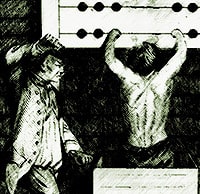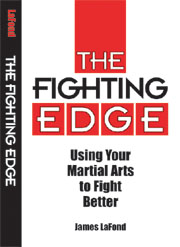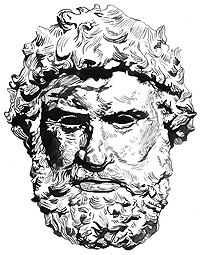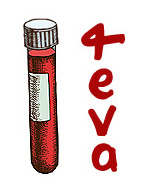This is the complete handout for the August 2013 seminar. Please print out and bring a copy.
Legal Context [LaFond]
A brief discussion of the legalities of edged-weapon use and the concept of justifiable force
Defensive Concepts [Frederick]
The core concepts behind practical defense against cutting and stabbing weapons
Address to non-Kenpo participants
Threat Cues [LaFond]
A basic assailant behavior outline, below.
Postures [if they have an edged-weapon]
1. Lead, [2 in 10] defensive, unlikely to attack, unlikely to pursue
2. Ready, [7 in 10] aggressive, likely to attack, may pursue
3. Reverse grip, [1 in 10] hyper-aggressive, will attack, will pursue
Forensic [depending on what kind of edged-weapon]
1. Razors, usually used for malicious attacks to face and neck and sometimes for defense in grappling situations, commonly injurious, rarely lethal
2. Swords, usually used to threaten, rarely injurious, rarely lethal
3. Shanks, always used to stab, commonly injurious, often lethal
4. Knives, come in many varieties, are often multipurpose, and their use is harder to predict based on the weapon’s properties than the three other types of edged-weapons
Knife Grips [how multipurpose edged-weapons are gripped is an indication of intent]
1. Fingered, will not stab, may slash, will slice
2. Butted, will stab, may slash, may slice
3. Hammer grip, will stab repeatedly, may slash, will rarely slice
4. Reverse grip, will stab repeatedly, will not slash, slicing is extremely rare
5. Thumbed, may stab, may slash, may slice, may integrate attack, which is very rare and indicates training or an associated trade such as meat-cutting
Behavioral [cues that indicate a likely edged-weapon aggression]
1. Hidden hand
2. Lone aggressor
3. Oblique approach
4. Lack of verbalization
Set 1
Neutralizing Edged-Weapon Threats
Defining stage one threats
1. Carrying [search clinic]
2. Deploying [deployment demonstrations]
3. Holding [examples]
4. Showing or Brandishing [examples]
5. Stalking [examples]
6. Warning [examples]
Addressing Holding Threats
1. Oblique
2. Squared
3. Warding
Neutralizing the Brandished Blade
1. Extended
2. Point on
3. Point down
4. Point out
5. Point across
Neutralizing/Escaping Stalks
1. Cornering
2. Driving/Pinning
Escaping the Knife Warning
Use the most appropriate grab or hold depending on the defender’s characteristics; grabbing long hair, for instance. Large defenders will be held less often, and should practice more weapon only warnings, particularly from the right side.
1. Facing, blade held to belly
2. Facing, point to side
3. Facing, edge to throat
4. Facing, point to throat
5. Right side, point to side
6. From behind, edge to throat
7. From behind, point to kidney
Relieving a Third Party from the Knife Warning
These are three-person scenarios. This should be done as a group workshop, with the seminar participants varying the scenario using the 7 warnings above, and experimenting with the best angle of relief for each position. Follow up with a discussion and then break.
Set 2
Prepared Defenses against Blade Escalations from the Ready Posture
The following escalations are predicated on a lethal response by an assailant or antagonist who is being successfully handled by a kenpoist, or by another type of martial artist using similar tactics, resulting in their deployment of a belt-case knife, pocket knife, pen knife, razor, pen, or pencil.
The defender’s position is listed first in kenpo terminology, the attacker’s action second.
Kicking Range
1. Right neutral bow after landing sidekick…low stepping stab
2. Left neutral bow after low kick…low reaching stab
3. Range restored in cat…high stepping slash to face/neck
Punching Range
1. Left neutral bow…high reaching slash
2. Left neutral bow…low reaching stab
3. Left neutral bow…low stepping stab with hold
4. Right neutral bow…low stepping stab
5. Right neutral bow…low stab with grab
Clinch
1. Thrusting wedge…low reaching stab
2. Tripping arrow…grab & low stab
3. Single leg…high reach around stab [behind upper arm]
Come-Along
Come-along holds should be applied, whenever practical, to the subject’s right side, to prevent the drawing of a knife or razor. The following come-along escalations assume the usual upright left-side hold, and represent three levels of threat, beginning with the highest.
1. The subject attempts to step around and stab
2. The subject attempts to slice hand or face
3. The subject draws their concealed weapon
4. The subject reaches for their concealed weapon
Floor Fighting
1. Mounted…chin push and throat slice with razor from the back
2. Mounted…arm grab and inward stab from the back
3. Scrambling…shirt grab and rising stab from the scramble
4. On back…mouth cover and chest stab from the mount
5. Experiment with variations. Considering the plethora of grappling defenses practiced by today’s martial artists, this segment should be extensive. Employ groups of three with positional rotation, as a third party is common in security situations.
Concept Review with Jim Frederick
Kenpo Edged-Weapon Combatives 2014: Survival
The concluding seminar will consist of 4 sets covering predatory attacks, psychotic attacks, running away, and improvised defensive weapons.
For details, context, concepts and real life examples read The Logic of Steel, available from Paladin Press.











